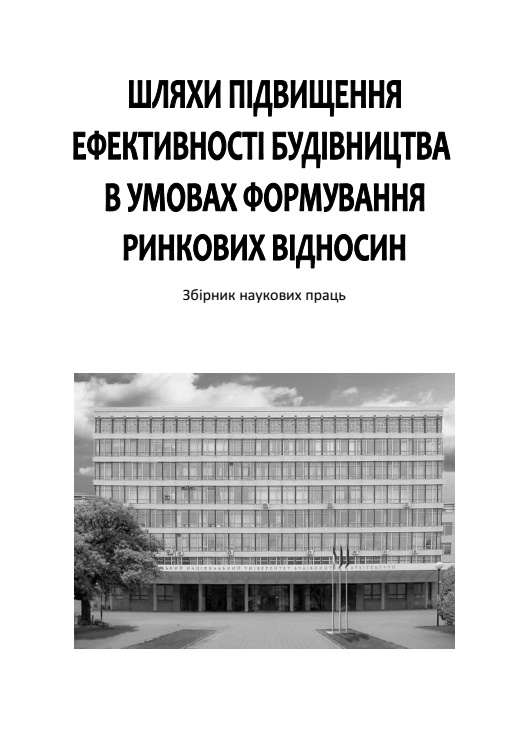Use of unmanned aerial vehicles to monitor the performance of work on scattered construction sites and ways to further implement them in construction in Ukraine
DOI:
https://doi.org/10.32347/2707-501x.2021.48(1).108-116Keywords:
drones, cloud technologies in construction, 3D model, orthophoto, remote control, construction organization, monitoring, construction project managementAbstract
The article covers the improvement of organizational and technological solutions of construction production through the use of unmanned aerial vehicles and special software for remote control of construction of scattered facilities (for example, the construction of cottages in Kyiv region), the experience of using UAVs.
Innovative approaches to the control of the life cycle of construction projects at the stages of engineering surveys and design works, zero cycle, construction of the above-ground part and further operation using drones and special software give the Ukraine construction sector companies a unique chance to realize their potential during the digital revolution and take their rightful place among world leaders.
Due to the lack of operational, accurate data and indicators that describe the state of the construction site, companies face such problems as management’s lack of up-to-date information on the project implementation progress, late detection of actual of the progress of work performed from design documentation, uncontrolled human factor in the process of checking volumes and quality of works performed by contractors, insufficient communication between project participants. Subsequently, these factors lead to budget overruns and non-compliance with the estimated project deadlines.
The experience of using UAVs in addressing such issues as the management’s lack of relevant information on state of affairs at construction site, late identification of actual deviations from the project documentation, uncontrolled influence of human factor in the process of checking the volume and quality of work performed by contractors, and insufficient communication between project participants.
Based on the practical experience gained in the use of drones, it was concluded that drones are an effective tool with a wide range of applications for monitoring zero-cycle work and erection of the above-ground part of buildings.
References
Improving Construction Productivity. McKinsey & Company. [Електронний ресурс]. – 2017. – Режим доступу: https://www.mckinsey.com/business-functions/operations/our-insights/improving-construction-productivity
Busta H. Balfour Beatty: Construction sites will be human-free by 2050. [Електронний ресурс]. – 2017. – Режим доступу: http://www.constructiondive.com/news/balfour-beattyconstruction-sites-will-be-human-free-by-2050/446352/.
Тугай О.А., Зельцер Р.Я., Колот М.А., Панасюк І.О. Організація контролю виконання будівельних робіт з використання дронів і спеціального програмного забезпечення // Наука та інновації. Науково-практичний журнал НАН України. – К., 2019. – Вип. 15(4):23-32. https://doi.org/10.15407/scin15.04.023
Зельцер Р.Я. Практика застосування дронів при реалізації будівельних проектів в Україні / Р.Я. Зельцер, М.А. Колот, І.О. Панасюк // Шляхи підвищення ефективності Будівництва в умовах формування ринкових відносин. – К.: КНУБА, 2018. – Вип.35. – С. 151-154.
Zeltser R. Organization of remote monitoring and control of construction works using drones and cloud technologies / M. Kolot, I. Panasyuk, R. Zeltser, V. Orishchenko // International scientific-practical conference of young scientists “Build-master-class-2018”, 28.11-30.11.2018. – Kyiv: KNUCA, 2018. – Р. 346-347.
The Evolution of Construction Technology. DroneDeploy. [Електронний ресурс]. – 2018. – Режим доступу: https://blog.dronedeploy.com/the-evolution-of-construction-technology-bdf3c120ed71.
5 Industries That Are Actually Ripe for Disruption. [Електронний ресурс]. – 2016. – Режим доступу: www.fortune.com/2016/05/13/5-industriesready-for-disruption.
Reinventing Construction: A Route to Higher Productivity. McKinsey&Company, McKinsey Global Institute. [Електронний ресурс]. – 2017. – Режим доступу: https://www.mckinsey.com/~/media/mckinsey/business%20functions/operations/our%20insights/reinventing%20construction%20through%20a%20productivity%20revolution/mgi-reinventing-construction-executive-summary.pdf
Andreas Renz, Manuel Zafra Solas. Shaping the Future of Construction. A Breakthrough in Mindset and Technology. Davos, World Economic Forum. [Електронний ресурс]. – 2016. – Режим доступу: https://www3.weforum.org/docs/WEF_Shaping_the_Future_of_Construction_full_report__.pdf
Corody C. 5 Valuable Business Lessons Learned About Drones in Construction. [Електронний ресурс]. – 2016. – Режим доступу: https://www.thedroneproshop.com/blogs/articles/5-valuable-lessons-learned-about-drones-in-construction
The Truth about Drones in Construction and Infrastructure Inspection. [Електронний ресурс]. – 2016. – Режим доступу: https://www.forconstructionpros.com/construction-technology/news/12231010/the-truth-about-drones-in-construction-and-infrastructure-inspection
The Rise of Drones in Construction. [Електронний ресурс]. – 2018. – Режим доступу: https://www.dronedeploy.com/blog/rise-drones-construction/
Downloads
Published
How to Cite
Issue
Section
License

This work is licensed under a Creative Commons Attribution 4.0 International License.
Authors who publish with this journal agree to the following terms:
- Authors retain copyright and grant the journal right of first publication with the work simultaneously licensed under a Creative Commons Attribution License that allows others to share the work with an acknowledgement of the work's authorship and initial publication in this journal.
- Authors are able to enter into separate, additional contractual arrangements for the non-exclusive distribution of the journal's published version of the work (e.g., post it to an institutional repository or publish it in a book), with an acknowledgement of its initial publication in this journal.
- Authors are permitted and encouraged to post their work online (e.g., in institutional repositories or on their website) prior to and during the submission process, as it can lead to productive exchanges, as well as earlier and greater citation of published work (See The Effect of Open Access).

